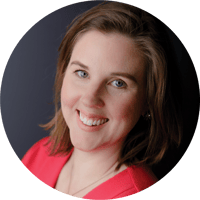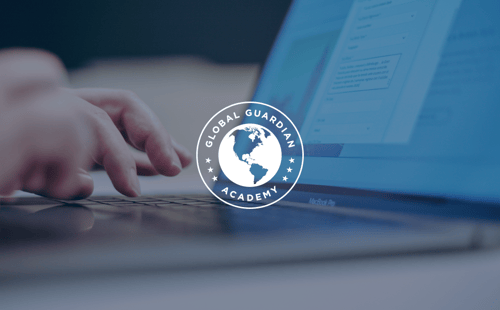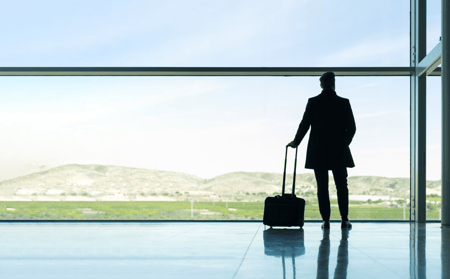Putting Security at the Top of People’s Minds
As the founder and CEO of Greylake Training Solutions, Meredith Moore relishes the challenge of helping her clients raise awareness of security and keep their workforce safe. “Security,” Moore admits, “is usually not at the top of people’s minds.”

A former Chicago public schools teacher and Peace Corps volunteer, Moore drifted into the world of security in 2011 when she was offered a position at the World Bank. During the four years she worked at the World Bank, she helped create a security training and awareness program and quickly realized “I love working in security. Building confidence, and help people make better decisions about their safety and security is incredibly rewarding.”
Global Guardian has partnered with Greylake Training Solutions to create Global Guardian Academy, which offers both bespoke and readymade online education programs in personal and corporate security that empower and inform.
“Focusing on the human factor is one of the most valuable ways to help our clients,” says Moore. “We center security education and awareness programs around human nature, which is critical but often overlooked.”
In our Global Guardian Partner spotlight, Moore sat down with our team to discuss the importance of creating a culture of security awareness—for companies, businesspersons, travelers, and families—and how e-learning has become an effective and indispensable tool of instruction, especially during the COVID-19 pandemic.
Q: Tell us about your background and how you got into creating learning and development programs on safety and security.
Moore: My background is a blend of work in the learning industry and the security industry. I have been a teacher, a trainer, and a learning professional for more than 20 years. I started out as a teacher in Chicago’s public schools. Then I had an international career in education—I was a Peace Corps volunteer in China, I worked for UNICEF in Nepal on a program to help conflict-affected students, and I worked for a nonprofit organization creating learning programs for rural communities in India, Nepal, and Bhutan.
Eleven years ago, I made the shift to security. In 2010 a friend approached me and said they were looking for someone to help them in the corporate security department at the World Bank. I said I knew nothing about security, but she noted “You are someone with the skills we need because we want to raise awareness, shift perceptions, create more education programs, do training, and we want to demystify security because people have a negative perception.”
At the World Bank, I helped create the security training and awareness program from scratch. I realized I love security and keeping people safe and secure, and helping them make better decisions about their safety and security was incredibly rewarding.
Four years later, I went to work at the International Monetary Fund. The IMF had a terrible incident in 2014 when the head of the office in Afghanistan was killed in a terrorist attack in Kabul. That prompted the question: “Why are we not teaching people safety skills, particularly when we send them to high-risk locations?” Over the course of four years, we trained hundreds of people through our live simulation-based course, which is certified by the United Nations for people traveling to high-risk locations.
We would take economists who were traveling to high-risk locations and put them through scenarios where they were taken hostage to test their ability to negotiate, to handle stress. We taught them how to survive an ambush, how to manage stress in a crisis, as well as medical skills in austere environments.
This was a powerful program and it cemented for me the fact that people learn best when they are connected to an experience and to each other. The participants went through a stressful situation together, which really bonded them and increased their leadership and decision-making skills. That solidified the fact that all the training I do about safety and security must be connected to people’s experience and people’s emotions.
In 2018, I left the IMF and started my own firm, which has now partnered with Global Guardian to bring clients Global Guardian Academy.
Q: What is the process of developing a security awareness program?
Moore: Security is usually not at the top of people’s minds so it can take time to recognize the value. We are not programmed to think about what would happen, we are more focused on the here and now—not the ‘what ifs?’.
The foundation of security awareness program is a core learning program so people know about emergency protocols, who to go to for help, emergency communications, incident response, and mitigation techniques.
This ability to make decisions in an emergency, is a critical life skill. In her book The Unthinkable, Amanda Ripley notes that in any emergency people are the first responders. The decisions and actions that people make in any emergency can determine their survival. If people don’t have any awareness of what to do it can be dangerous. Educating and informing people through learning, communications, and awareness is a key component of any corporate security program.
 Q: Why is the Global Guardian Academy unique?
Q: Why is the Global Guardian Academy unique?
Moore: I am excited to work with Global Guardian because it is a comprehensive solution for security services. Any security manager has to deal with different vendors, products, and services; it can become overwhelming. Global Guardian has a streamlined process with its duty of care program and the app. Including educational services, customized learning programs, and awareness programs in Global Guardian’s portfolio makes sense because it is a critical business need.
Q: How do you impress upon clients the need to prioritize security?
Moore: Security is very reactive. It is human nature not to think about these things. Everyone has a different risk appetite. Think of it as a responsibility to safeguard your workforce, uphold your duty of care. Every company has an obligation to protect its employees.
There are a multitude of threats out there. Although high-profile threats like terrorist attacks do not happen every day, incidents like robberies, car accidents, medical emergencies, sexual harassment, and assault, happen frequently. Chances are most of us have lived through a critical incident in our lives Employees need to be confident, prepared and know what to do in an emergency.
Another way to think about this is to imagine the the consequences if you don’t adequately prepare your workforce. If you fail to train and prepare your employees you might run the risk of lawsuits, negative PR issues and even physical harm. It should not be the primary motivator to spur people to act, but there countless examples of organizations suffering a fall-out after a security incident
Q: What types of courses are going to be created for the Global Guardian Academy?
Moore: We are launching the Global Guardian Academy with three core courses—travel safety awareness , travel health awareness, and cyber security essentials. That’s just the tip of the iceberg. We have identified many different content areas that are critical for people to know.
Safety and security skills might be something you learn at work but it carries over to our private lives as well. Workers do not turn off their security awareness when they get home. We are developing more courses for families. If you are traveling with your family what do you need to be aware of? If you have kids who are online, how do you protect them from exploitation and abuse? Women’s security awareness is also an area I have been heavily involved in and am very passionate about . What do women need to know to maintain better situational awareness? What are the threats that women are more vulnerable to? How can they protect themselves? What are the resources for help? We also have more specific travel safety courses planned. Many of us will be going back to the workplace, if we haven’t already-- so how does COVID-19 impact our ability to be safe in the office again? Those are all courses we are going to be rolling out over the next 6-12 months.
As far as frequency, our goal is to have six to eight courses per year. With those foundational courses we can create other smaller learning elements or microlessons to keep people engaged beyond the courses.
Q: How frequently do these courses need to be taken?
Moore: The foundation courses should be taken every two years. In between those two years, clients could get various information to reinforce what they have learned—for example, a checklist, a video, a short course so the skills do not get lost. A lot of these skills, especially operational skills, are perishable. General security awareness—who do I call in an emergency? what do I need to be aware of?—those types of things need to be reinforced regularly. It does not mean taking the course all over again. It could be a short microlesson or a poster. There are a lot of ways to reinforce key messages that are not a burden for a learner.
Q: What are the benefits of e-learning versus in-person training?
Moore: E-learning is exploding right now. Across the world we are using it because it is scalable and flexible. You can deploy it to anybody, anywhere, anytime. People can do it on their own time because it is mobile responsive, and it is cost effective. While in-person training is effective, it is just not as feasible in today’s world. E-learning is also a consistent experience—everyone gets the same experience. If it is done right, it can be creative, engaging, and fun. People are doing less and less in-person training, particularly due to the pandemic.
The instructional design that you put into a digital learning program will make or break it. Some people think you can take a PowerPoint—put it online and people will benefit but that is not how most people learn. People learn from an emotional connection. They respond to stories; it has to be relevant and authentic for them and it must be presented in a way that does not produce cognitive overload. Our brains shut down and stop absorbing information when we are overwhelmed with large chunks of information.
When you have a well-designed learning program people walk away feeling more confident, more engaged, and more able to retain that information.
Q: Is there data that backs up the effectiveness of these courses?
Moore: In 2019, I created a program at a technology company for their receptionists about recognizing the signs of workplace violence and how to effectively communicate to de-escalate a tense situation. The before and after results were astonishing. Prior to the training, the majority said they had no idea what the behavioral indicators are that someone could be violent. They did not feel confident that they could defuse an angry visitor—and they had very little awareness of what the consequences of inaction were. After the sessions, the increase in confidence, understanding, and ability to apply the lessons to their everyday lives was enormous—a 150 percent increase in confidence. I was very proud!
Q: How long does it take to develop a customized curriculum for a client?
Moore: When we create a custom course for a client, the first thing seek to understand is their audience and what is important to them. Many security professionals and subject matter experts think that the nitty gritty of risk assessments and security assessments is important, but we need to boil it down to what is important to the audience. We ask: What are the objectives? What is your vision? What is the most important thing you need to get across to your employees about security or safety? What are your policies? Are there security policies? What are the resources? We work with clients to ensure that any learning program we design aligns with their policies and resources, and reflects their operations and business needs because everyone is unique. Then we spend time thinking about how we achieve their objectives. What is the best learning methodology to align to your goals? We then build the course with a heavy emphasis on instructional, user experience and visual design. The editing process can take time because stakeholders often give many rounds of feedback. We then conduct quality assurance and make sure that everything looks perfect.It usually takes anywhere between four to six weeks to create a 30-minute custom e-learning course. It is a very close, collaborative process.
Q: What are some custom courses you have built in the past?

Moore: Travel safety and security is an area of expertise for Global Guardian, and I also have a lot of experience in that area. Workplace violence prevention, crisis management, personal preparedness, diversity and inclusion issues, resiliency, mental health, these are all areas I have worked on and continue to work on.
Specifically, I am interested in helping people understand what drives their perceptions and actions and what are the barriers to making sound decisions. The application of heuristics and biases are important in security and we over overlook. My goal is to bring an understanding how our brains and our behaviors respond in an emergency to everyone—so we can ensure better outcomes in a crisis. Oftentimes, our security protocols are not aligned with how people act or behave. The learning programs I create center around human nature and emergency response.
Focusing on human nature is the most valuable way we help our clients.
To learn more about Global Guardian Academy, visit https://academy.globalguardian.com




